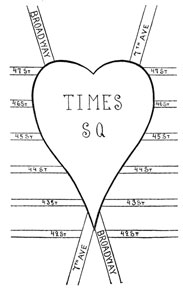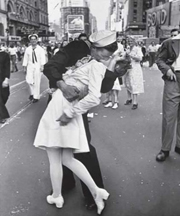Here are 10 things you should know about Winnie Lightner, born 123 years ago today. After starring on in vaudeville and on Broadway, she made just 15 films, but her legacy endures.
Tag: Times Square
New York as it was
Frank Oscar Larson (1896-1964) was born in Greenpoint, Brooklyn, of Swedish immigrant parents and lived in Flushing, Queens most of his life. As an adult, Larson spent his days at a branch of the Empire Trust Company (now Bank of New York Mellon), working his way up through the ranks from auditor to vice-president, and spare time on weekends taking photographs of street life throughout New York City.
He was an accomplished photographer who eloquently documented 1950s Chinatown, the Bowery, Hell’s Kitchen, City Island, Times Square, Central Park, and much more.
This exhibition is compiled from thousands of negatives recently discovered stored away in his daughter-in-law’s house in Maine in 2009. Soren Larson, his grandson and a television news camera man and producer, has been scanning and printing the 55-year-old images found stored in over 100 envelopes filled with mostly medium format, 2-1/4 x 2-1/4″ negatives, and neatly noted by location and date in Larson’s own hand.
Frank Oscar Larson: 1950s New York Street Stories is on view at the
The above text is from
Times Square Tintypes: Times Square
MY STREET
 FORTY-SECOND Street and Seventh Avenue . . . Everybody calls it Broadway. The Rialto Theatre. A hanging says it is “The House of Hits”. . . . But the big line is at the Paramount . . . Sightseeing buses . . . Old women sitting in them . . . Making a living as decoys . . . See the Bowery . . . A lecture through Chinatown . . . Why, all the Chinks own restaurants on Broadway . . . There ain’t no Chinamen in Chinatown . . . The chap who is shouting that he is going to point out the historic places . . . Did you know he only arrived here from Portland last week? . . . See the old man selling The Birth Control Review . . . He’s doing it for the wife and kiddies. . . .
FORTY-SECOND Street and Seventh Avenue . . . Everybody calls it Broadway. The Rialto Theatre. A hanging says it is “The House of Hits”. . . . But the big line is at the Paramount . . . Sightseeing buses . . . Old women sitting in them . . . Making a living as decoys . . . See the Bowery . . . A lecture through Chinatown . . . Why, all the Chinks own restaurants on Broadway . . . There ain’t no Chinamen in Chinatown . . . The chap who is shouting that he is going to point out the historic places . . . Did you know he only arrived here from Portland last week? . . . See the old man selling The Birth Control Review . . . He’s doing it for the wife and kiddies. . . .A million lights that dim the stars. . .”
Heart of the World . . .”
A helping hand—they’re all for sale,
On Broadway, Broadway. . . .
When you’re on top;
Same crowd hissing you and dismissing you
If you should flop . . .
Tomorrow is another day . . .
The Heart of the World. . . .”
Goodbye to another glorious gal

Remember the photo on the right? Sure you do, we’ve all seen it dozens of times. It was taken by the great Alfred Eisenstaedt on August 15, 1945 — VJ Day — in Times Square, and it captures, as Emma Brown put it in today’s Washington Post, “the relief, euphoria and optimism that Americans felt at the end of a horrible conflict.”
It’s not known just who the sailor was, but the identity of the nurse he’s smooching so enthusiastically was established some years. It was Edith Shain, who died, aged 91, on Sunday, as announced on her web site.
Other women claimed to be the nurse over the years, but Eisenstaedt flew to California in 1979 to meet with Ms. Shain, and after one look at her legs, he said she was the one.
 Life.com, the web site for the magazine’s photo archive, released a statement saying, “While Life magazine itself never officially endorsed any of the claims by any of the men or women who came forward saying that they were the sailor or the nurse in the photograph, Shain’s claim is the one that, over the years, has held up best and has been most widely accepted (and most often celebrated).”
Life.com, the web site for the magazine’s photo archive, released a statement saying, “While Life magazine itself never officially endorsed any of the claims by any of the men or women who came forward saying that they were the sailor or the nurse in the photograph, Shain’s claim is the one that, over the years, has held up best and has been most widely accepted (and most often celebrated).”
Shain, who worked enthusiastically on behalf of veterans’ causes in the years after she’d become widely accepted as the authentic recipient of that famous celebratory buss, is survived by three sons, six grandchildren and eight great-grandchildren.
